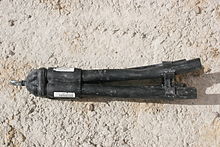Downhole heat exchanger: Difference between revisions
No edit summary Tags: Mobile edit Mobile app edit Android app edit |
m →top: | Removed parameters. | Use this tool. Report bugs. | #UCB_Gadget |
||
| Line 5: | Line 5: | ||
[[File:Oberes Ende einer Erdwärmesonde.jpg|thumb|Top end of a Downhole heat exchanger]] |
[[File:Oberes Ende einer Erdwärmesonde.jpg|thumb|Top end of a Downhole heat exchanger]] |
||
A '''downhole heat exchanger''', (DHE) also called a '''borehole heat exchanger''', (BHE) is a [[heat exchanger]] installed inside a vertical or inclined [[borehole]].<ref>{{cite web |url=http://geoheat.oit.edu/bulletin/bull20-3/art1.pdf |title=Downhole Heat Exchangers |publisher=Geo-Heat Center - Oregon Institute of Technology |
A '''downhole heat exchanger''', (DHE) also called a '''borehole heat exchanger''', (BHE) is a [[heat exchanger]] installed inside a vertical or inclined [[borehole]].<ref>{{cite web |url=http://geoheat.oit.edu/bulletin/bull20-3/art1.pdf |title=Downhole Heat Exchangers |publisher=Geo-Heat Center - Oregon Institute of Technology |access-date=21 April 2013}}</ref> It is used to capture or dissipate heat to or from the ground. DHT's are used for [[geothermal heating]], sometimes with the help of a [[geothermal heat pump]]. Downhole heat exchangers, like other use of geothermal energy, have the potential to significantly contribute to the reduction of {{CO2}} emissions.<ref>{{Cite web|title=Geothermal Energy - Professur für Geothermal Technologies|url=https://www.bgu.tum.de/en/gtt/research/geothermal-energy/|access-date=2021-01-15|website=www.bgu.tum.de}}</ref> In northern Europe, DHE are already widely deployed.<ref>https://www.mbie.govt.nz/assets/14861fe5a3/geothermal-barriers-update-1.pdf {{Bare URL PDF|date=March 2022}}</ref> |
||
==Types== |
==Types== |
||
Latest revision as of 17:07, 25 February 2024
This article needs additional citations for verification. (April 2013) |



A downhole heat exchanger, (DHE) also called a borehole heat exchanger, (BHE) is a heat exchanger installed inside a vertical or inclined borehole.[1] It is used to capture or dissipate heat to or from the ground. DHT's are used for geothermal heating, sometimes with the help of a geothermal heat pump. Downhole heat exchangers, like other use of geothermal energy, have the potential to significantly contribute to the reduction of CO2 emissions.[2] In northern Europe, DHE are already widely deployed.[3]
Types[edit]
U-tube[edit]
The heat exchanger usually consists of one or two u-tubes through which the carrier fluid, usually water, circulates. The space around the u-tubes is filled with groundwater or backfilled with thermally conductive grout.
Open pipe[edit]
Another design uses a single open pipe to flow water downward. The water then returns through the annular gap between the pipe and the casing. This design provides better thermal contact than u-tubes, but risks contamination by groundwater. Since this involves practically no downhole equipment, these systems usually only go by the name of borehole heat exchangers (BHT).
Standing column well[edit]
If no casing is installed and groundwater is permitted to charge the system, this arrangement is no longer a BHT, but rather a standing column well.
External links[edit]
- Video documentation: Installation of a downhole heat exchanger
- John W. Lund: The use of downhole heat exchangers (2003)
References[edit]
- ^ "Downhole Heat Exchangers" (PDF). Geo-Heat Center - Oregon Institute of Technology. Retrieved 21 April 2013.
- ^ "Geothermal Energy - Professur für Geothermal Technologies". www.bgu.tum.de. Retrieved 2021-01-15.
- ^ https://www.mbie.govt.nz/assets/14861fe5a3/geothermal-barriers-update-1.pdf [bare URL PDF]
